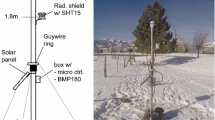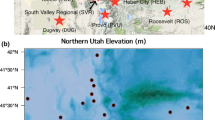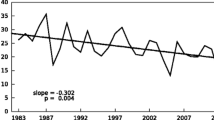Abstract
A variety of methods are available to calculate daily mean temperature. We explore how the difference between two commonly used methods provides insight into the local climate of Churchill, Manitoba. In particular, we found that these differences related closely to seasonal fog. A strong statistically significant correlation was found between the fog frequency (hours per day) and the diurnal temperature asymmetries of the surface temperature using the difference between the min/max and 24-h methods of daily temperature calculation. The relationship was particularly strong for winter, spring and summer. Autumn appears to experience the joint effect of fog formation and the radiative effect of snow cover. The results of this study suggests that subtle variations of diurnality of temperature, as measured in the difference of the two mean temperature methods of calculation, may be used as a proxy for fog detection in the Hudson Bay region. These results also provide a cautionary note for the spatial analysis of mean temperatures using data derived from the two different methods particularly in areas that are fog prone.









Similar content being viewed by others
References
Bonacci O, Zeljkovic I, Sakic Trogrlic R, Milkovic J (2013) Differences between true mean daily, monthly, annual air temperatures and air temperatures calculated with three equations: a case study from three Croatian stations. Theor Appl Climatol 114:271–279
Brooks CEP (1921) True mean temperature. Mon Weather Rev 49:226–229
Collison P, Tabony RC (1984) The estimation of mean temperature from daily maxima and minima. Meteorol Mag Lond 113:329–337
Etkin DA (1991) Break-up in Hudson Bay: its sensitivity to air temperatures and implications for climate warming. Climatol Bull 25:21–34
Gagnon AS, Gough WA (2005) Trend and variability in the dates of ice freeze-up and break-up over Hudson Bay and James Bay. Arctic 58(4):370–382
Gagnon AS, Gough WA (2006) East/west asymmetry in ice thickness trends over Hudson Bay, Canada. Clim Res 32:177–186
Gough WA, Allakhverdova T (1999) Limitations of using a coarse resolution model to assess climate change induced sea-ice variability in Hudson Bay. Can Geogr 43:415–422
Gough WA, Leung A (2002) Hudson Bay permafrost, recent climate model results. Reg Environ Chang 2:177–184
Gough WA, Gagnon AS, Lau HP (2004) Interannual variability of Hudson Bay ice thickness. Polar Geogr 28(3):222–238
Harris SA, Pedersen JH (1995) Comparison of three methods of calculating air temperature from electronic measurements. Z Geomorphol 39:203–210
Hartzell FZ (1919) Comparison of methods for computing daily mean temperatures: effect of discrepancies upon investigations of climatologists and biologists. Mon Weather Rev 47:799–801
Hochheim KP, Barber DG (2010) Atmospheric forcing of sea ice in Hudson Bay during the fall period, 1980–2005. J Geophys Res 115(C05009)
Hochheim KP, Lukovich JV, Barber DG (2011) Atmospheric forcing of sea ice in Hudson Bay during the spring period, 1980–2005. J Mar Syst 88:476–487
Laidler GJ, Gough WA (2003) Climate variability and climate change: potential implications for Hudson Bay coastal communities. Polar Geogr 27:38–58
McGovern PG, Gough WA (2014) East–west asymmetry in coastal temperatures of Hudson Bay as a proxy for sea ice. Arctic (submitted)
Reicosky DC, Winkelman LJ, Baker JM, Baker DG (1989) Accuracy of hourly air temperatures calculated from daily minima and maxima. Agric For Meteorol 46:193–209
Rouse WR (1991) Impacts of Hudson Bay on the terrestrial climate of the Hudson Bay lowlands. Arct Alp Res 23(1):24–30
Trewin B (2004) Effects of changes in algorithms used for the calculation of Australian mean temperature. Aust Meteorol Mag 53:1–11
Weber RO (1993) Influence of different daily mean formulas on monthly and annual averages on temperature. Theor Appl Climatol 47:205–213
Weiss A, Hays CJ (2005) Calculating daily mean temperatures by different methods: implications from a non-linear algorithm. Agric For Meteorol 128:57–65
Zeng X, Wang A (2012) What is monthly mean land surface temperature? Eos 93(15):156–157
Author information
Authors and Affiliations
Corresponding author
Rights and permissions
About this article
Cite this article
Gough, W.A., He, D. Diurnal temperature asymmetries and fog at Churchill, Manitoba. Theor Appl Climatol 121, 113–119 (2015). https://doi.org/10.1007/s00704-014-1227-7
Received:
Accepted:
Published:
Issue Date:
DOI: https://doi.org/10.1007/s00704-014-1227-7




